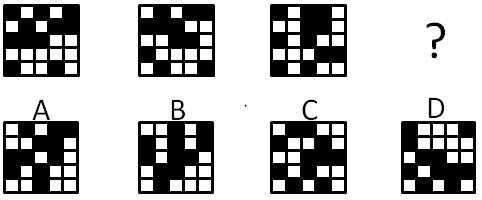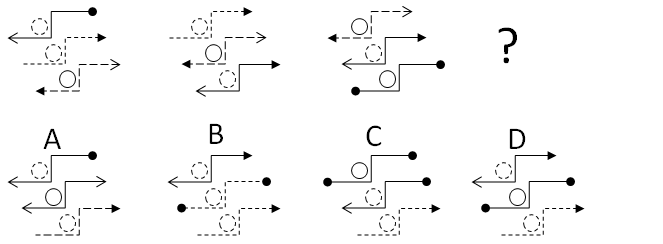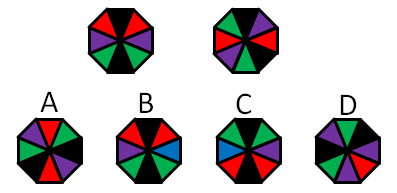Guidance Abstract
This guidance includes a series of general guidelines on optimization of test results as well as rules and examples regarding the questions used in the tests. Since the questions used across the tests have significant variation in their presentation it is not possible to go into detail on all the permutations that exist. Many different colors, shapes and patterns are used to illustrate a single logic/rule, leading to many different individual questions in the same way as 2-addition table can be shown as 2-4-6-8 or 8-10-12-14. Regardless of the presentation the aim is for you to identify the logic of the elements of the question and use this to select the correct answer from the presented options. The evaluation of your cognitive ability is derived from your aptitude to identify the rule/logic and apply it to the solutions.
In general
- Answer as many questions as possible. Each answer will increase the probability of an increased score while questions that remain un-answered cannot impact the score.
- Do not get stopped by difficult questions. Spending a long time on a question reduces the time you have available for easier questions. If some questions cause extra difficulty, chose an answer quickly and move on to the next question.
- Do not skip questions. Always select an answer even if it is just a guess. Unless you are told otherwise, it is only correct answers that are used for evaluation and a correct guess is equal to a correct calculation.
- Read the entire question and answer only the question that is stated. Many questions can seem alike with small but significant variations, such as highest/lowest, true/false, same as/opposite of.
- Learn as many rules and logics as possible. This will make you faster at identifying which one to use on the question.
- Practice makes perfect so train as much as possible to master the words, arithmetic, logics and time pressure.
The tests contain three categories of questions; Numeric, Verbal and Abstract, i.e. numbers, words and shapes. Each of these has distinct characteristics and will be presented in individual tabs.
Abstract
Is made up of the sub-categories Visual Analogies, Visual Series and Common Features, with the purpose of identifying the ability to identify the connectivity and logic causality from shapes and abstract presentations.
Visual Analogies contains these types of questions:
Shape A is to shape B as shape C is to ?
The question is answered by identifying the change that occur between shape A and shape B and then apply this change to shape C to find the correct answer from the options.
E.g. shape B is shape A rotated 180 degrees and the correct answer is shape C rotated 180 degrees:

It could also be a shape that transforms from a trapezoid to a circle:

Or it could be a pattern that moves inwards in a shape:

It could be a combination of things – the shape rotate 90 degree clockwise and the triangles switch color:

Or as in this example where the diagonal series switch shapes and the right-hand series increase the number of shapes by one:

The spacial dimension can also be included such as 3D and mirror reversal:


Sometimes several dimensions are in play and it can be a valid strategy to just choose an answer without going in-depth in the question to save time for the rest of the questions:

Shape 4 from left becomes shape 1 and shape 5 becomes shape 2 while shapes 1-3 become shapes 3-5 and the new shape 5 switches color.
The variations are almost endless and it is not possible to present them all here. Shapes and elements can change color, size, number of sides, position or rotate clockwise or counter-clockwise and the number of elements can increase or decrease etc.
Visual Series contains these types of questions:
What is the next shape in the sequence below?

and
What is the missing shape in the sequence below?

The purpose is to find the connectivity between the shapes in the sequence and use this logic to identify the correct answer (missing shape). As always there is a multitude of variations due to the limitless visual possibilities. Shapes and elements can change color, size, number of sides, position or rotate clockwise or counter-clockwise and the number of elements can increase or decrease etc.
The more variables in play, the more challenging it becomes to find the correct answer. For this reason it can be a strategy to focus on one dimension at a time and exclude the answer options that do not fit until one is left.
E.g.:

The correct answer is not obvious. But by focusing on the lowest row of squares in the shapes it can be seen that the black fields move right and furthermore that it is the entire outer ring of squares that move counter clockwise. C and D are the only answer options that have the bottom row moving and only C have the entire outer ring moving the right way. Now the correct answer has been found without having to identify the clockwise movement of the inner ring.
A similar approach can be used for other complex shapes:

Here we can start by focusing on the large circles to make the first exclusion. It can be seen that the circle moves a level up for each move to the right in the sequence. By following this logic it is clear that the top circle has to be stippled and that the middle circle has to be a full line. The lower circle cannot be identified as it has not been revealed yet. Only answer option A and D fulfill the logic. Since also the lines move up and to the right it can be seen that the top line has to be a full line with two different arrowheads. D is the only option that fit the criteria and the correct answer has been found.
Some questions look complicated at first glance but have simple solutions.
E.g.:

The vertical rows of each shape move left as the sequence progress to the right.
and:

The same shape rotate 90 degrees clockwise as the sequence progress to the right.
Common Features contains these types of questions:
Which one of the following figures does not fit with the rest?

and
The two figures above share a common feature. Which of the figures below share this common feature?

and
The two figures above share a common feature. Which of the figures below does not share this common feature?

The purpose is to find the common feature between the shapes and use this to identify the correct answer. As always there is a multitude of variations due to the limitless visual possibilities. Common features can be same or missing color, size, number of sides/elements, position, direction, angles or a combination of them.
The more variables in play, the more challenging it usually becomes to find the correct answer. For this reason it can be a strategy to focus on one dimension at a time and exclude the answer options that do not fit until one is left.
E.g.: Which one of the following figures does not fit with the rest?

By looking at one field at a time, starting with the top row, it can be identified that the corner-fields contain identical shapes in A, B, and D. Using the corner-field logic on the bottom row identifies the same pattern. The conclusion is that C does not fit with the rest and is selected as the correct answer. Even if not all possibilities for fit has been investigated, the ”identical shapes in corner-fields”-solution is so likely that it can be selected. A quick scan of the remaining fields shows no obvious pattern and further in-depth investigation would take more time than it is reasonable to invest in one question.

In this example all of the elements in the shapes are the same but no two shapes are visual identical. The solution is found in the relationship between the elements. In A, C and D the triangle and the trapezoid are pointing in the direction of the end of the line without and arrowhead. In B this is not the case which makes B the correct answer.
